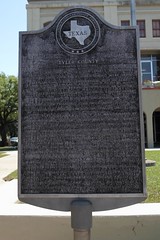
City of Tyler. In area opened 1839 to white settlers by Republic of Texas victories over Cherokee Indians whose trails led the way to good springs, fine farmlands, useful salines. The first Legislature of the state of Texas named the town (founded 1846) for President John Tyler, who signed the resolution annexing Texas to the United States. Originally a farm market, Tyler in early years had few men of wealth, but by 1860 was known for good schools, churches and cultured citizens. Several men here raised and commanded troops in Civil War. After mid-1863 this was transportation headquarters for Trans-Mississippi Department of the Confederacy. It had an ordnance factory and was site of Camp Ford -- the largest P.O.W. post west of the Mississippi. In 1870s important as site of railroad shops and roundhouse. Developed industries, manufacturing, fruit and vegetable packing, shipping, expanding economy. Furnished Texas with statesmen, including Governors Richard B. Hubbard (in office 1876-1879), O. M. Roberts (1879-1883) and James Stephen Hogg (1891-1895). Upon discovery of nearby East Texas oil field in 1931, became investment, banking, servicing center. Home of Tyler Junior College; Annual Rose Festival. #7762
by Texas Historical Commission #07762 of the Texas Historical Marker series
Colour: black
Wikimedia:
Flickr:


